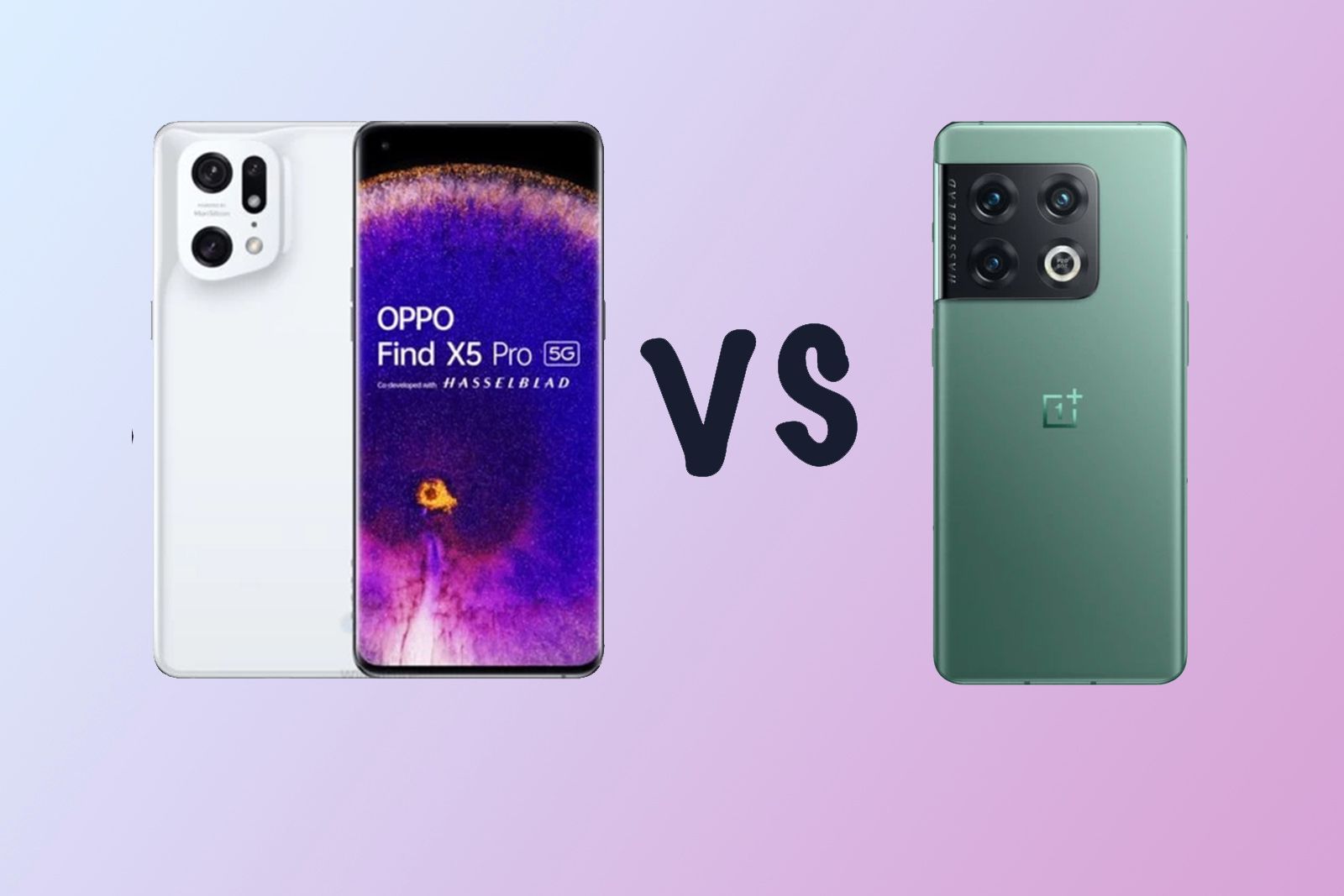Oppo announced its Find X5 Series on 24 February, with three devices in the line-up comprising the Find X5 Pro, Find X5 and Find X5 Lite. OnePlus meanwhile, announced the OnePlus 10 Pro in China on 11 January and globally on 31 March.
You can read how the Find X5 Series compares to each other in our separate feature but here we are looking at how the top-of-the-pack Find X5 Pro compares to the OnePlus 10 Pro. We've added a couple of the Find X5 details too just for reference in case you are considering that model too. There's no standard OnePlus 10 model as yet.
OnePlus 10 Pro - 8+128GB
Design
- Oppo Find X5: 163.7 x 73.9 x 8.5mm, 218g, IP54
- Oppo Find X5 Pro: 160.3 x 72.6 x 8.7mm, 196g, IP68
- OnePlus 10 Pro: 163 x 73.9 x 8.55mm, IP68
The Oppo Find X5 Pro and the Find X5 both have unique camera housings on their rears. Rather than a standard square or rectangle, the camera housing is angled at the bottom and built into the respective ceramic and glass backs offered by the devices.
There are two main lenses, along with a smaller lens and the flash module. On the front of the X5 Pro and X5, you're looking at curved edge displays with a punch hole front camera situated in the top left.
The OnePlus 10 Pro offers a similarly standout camera housing on its rear. It's more traditional in terms of the fact that it's a standard square, but it's most definitely a talking point. With three large lenses and the fourth circle making up the flash module, it's all about symmetry.
Like the Oppo Find X5 Pro and Find X5, the OnePlus 10 Pro has a curved display with a punch hole camera in the top left corner. All devices in this comparison have Hassleblad branding on the rear, though OnePlus opts for a slightly more subtle approach and places it on the camera housing, while the Oppo devices feature it more prominently on the rear.
In terms of waterproofing, the Oppo Find X5 Pro and OnePlus 10 Pro are both IP68 water and dust resistant, while the Find X5 is IP54.
Display
- Oppo Find X5: 6.55-inch, Full HD+, 10-bit colour, 120Hz
- Oppo Find X5 Pro: 6.7-inch, Quad HD+, 10-bit colour, 1-120Hz
- OnePlus 10 Pro: 6.7-inch, Quad HD+, LTPO, 1-120Hz, Dual Colour Calibration
The Oppo Find X5 Pro has a 6.7-inch LTPO AMOLED display with a Quad HD+ resolution. The Oppo Find X5 meanwhile, has a slightly smaller 6.55-inch LTPS AMOLED display with a Full HD+ resolution.
Both the Find X5 Pro and the Find X5 have 10-bit colour displays and they both offer support for HDR. The X5 Pro has a variable refresh rate between 1Hz and 120Hz, while the Find X5 offers just a standard 120Hz refresh rate rather than adaptive.
The OnePlus 10 Pro has a 6.7-inch LTPO AMOLED display like the Find X5 Pro. It also offers a Quad HD+ resolution and support for HDR, as well as an adaptive refresh the between 1Hz and 120Hz.
OnePlus also has a feature called Dual Colour Calibration, which is designed to deliver accurate and natural colours at two levels of brightness.
Hardware and specs
- Oppo Find X5: Qualcomm SD888, 8GB RAM, 256GB storage, 4800mAh battery, 85W charging
- Oppo X5 Pro: Qualcomm SD 8 Gen 1, 12GB RAM, 256GB storage, 5000mAh battery, 85W charging
- OnePlus 10 Pro: Qualcomm SD8 Gen 1, 8/12GB RAM, 128/256GB storage, 5000mAh
The Oppo Find X5 Pro runs on the Qualcomm Snapdragon 8 Gen 1 chipset, supported by 12GB of RAM and 256GB of storage. There is no microSD support for storage expansion. The Oppo Find X5 runs on the 2021 Qualcomm Snapdragon 888 chipset and it offers 8GB of RAM and 256GB of storage.
Like the Find X5 Pro, the OnePlus 10 Pro runs on the latest Qualcomm Snapdragon 8 Gen 1 SoC, along with a choice of 8GB of RAM or 12GB of RAM and 128GB or 256GB of storage. Again, there is no microSD for storage expansion.
The Oppo X5 Pro and the OnePlus 10 Pro both have 5000mAh batteries on board and they both support Oppo's 80W SuperVOOC wired fast charging and 50W AirVOOC wireless charging. The Find X5 has a 4800mAh battery (though remember it has a smaller screen to power), and it supports 65W fast charging and 30W wireless charging.
Cameras
- Oppo Find X5: Triple rear (50MP main, 50MP ultra wide, 13MP telephoto), 32MP front
- Oppo Find X5 Pro: Triple rear (50MP main, 50MP ultra wide, 13MP telephoto), 32MP front
- OnePlus 10 Pro: Triple camera (48MP, 50MP, 8MP), 32MP front
The Oppo Find X5 Pro and Find X5 both come with a triple rear camera system that offers a 50-megapixel main camera, 50-megapixel ultra wide camera and a 13-megapixel telephoto camera. There are some differences in the lenses however, with the Pro model being superior on paper.
The OnePlus 10 Pro also has a triple rear camera, though with a different make up. You'll find a 48-megapixel f/1.8 OIS primary camera, 50-megapixel 150-degree ultra wide angle camera and an 8-megapixel f/2.4 telephoto camera.
There are differences in terms of features offered, though all three models offer the Hassleblad partnership.
On the front, the Oppo Find X5, Find X5 Pro and OnePlus 10 Pro all have a 32-megapixel snapper with f/2.2 aperture.
OPPO Find X5 Pro Dual-SIM 256GB ROM + 12GB RAM (GSM Only | No CDMA) Factory Unlocked 5G Smartphone (Ceramic White) - International Version

Price
The Oppo Find X5 starts at £749 in the UK, €999 in Europe and $1125 in the US, while the Find X5 Pro starts at £1049 in the UK and €1299 in Europe.
The OnePlus 10 Pro meanwhile starts at £799 in the UK, £899 in Europe or $899 in the US for the base model, creeping up to £899 and €999 for the top model in the UK and Europe, respectively.
Conclusion
As you might expect, there are a lot of similarities between the Oppo Find X5 and the OnePlus 10 Pro. They differ in design and the model you prefer will come down to personal preference here, though both have the same size and resolution display, the same display capabilities and the same hardware.
The camera offering is different - even though both have a tie in with Hassleblad - and as we mentioned, they differ in their look too. The Find X5 meanwhile, has some similarities to the OnePlus 10 Pro, though it has a smaller and less resolute display, as well as a drop in processor and battery, even if still very capable.

